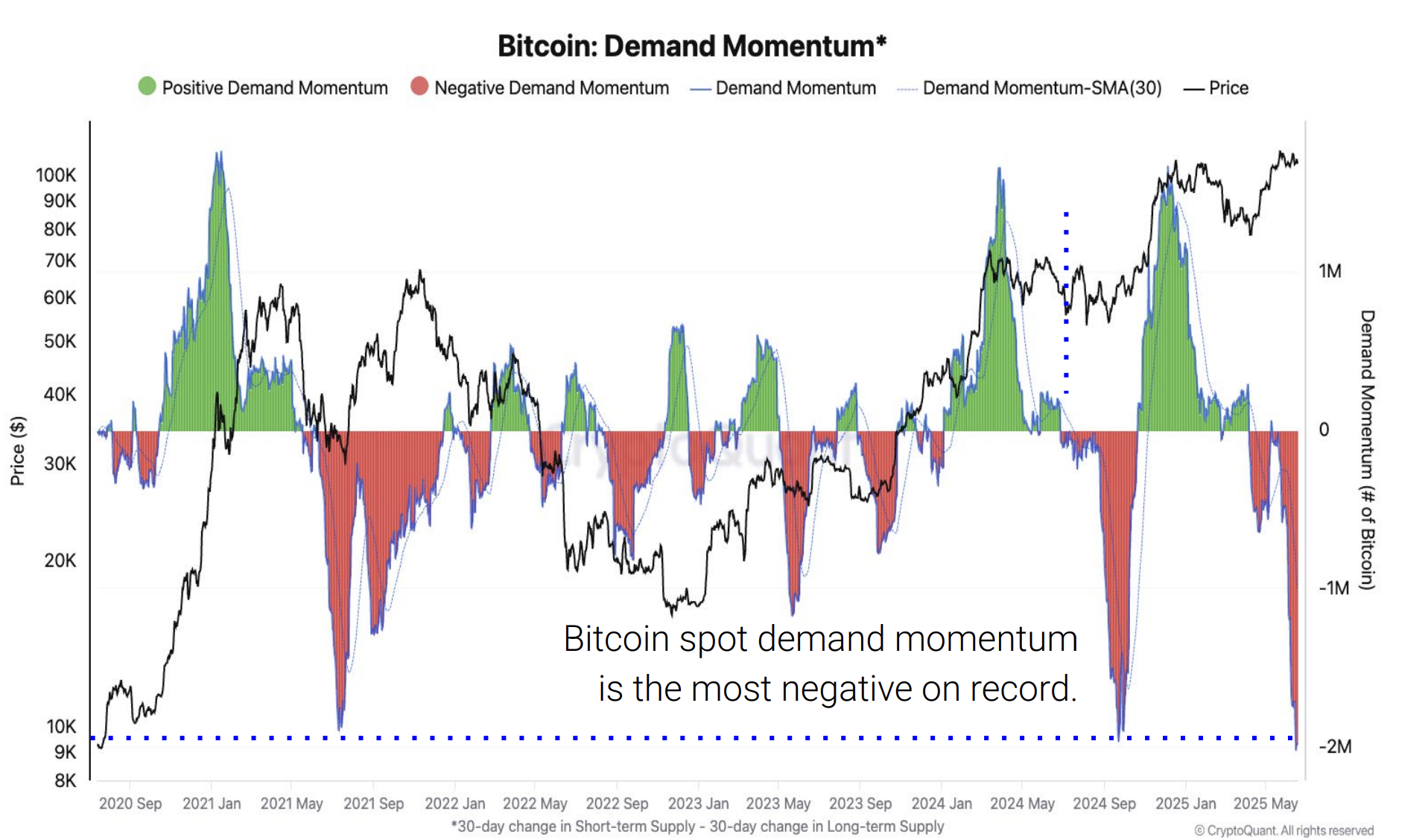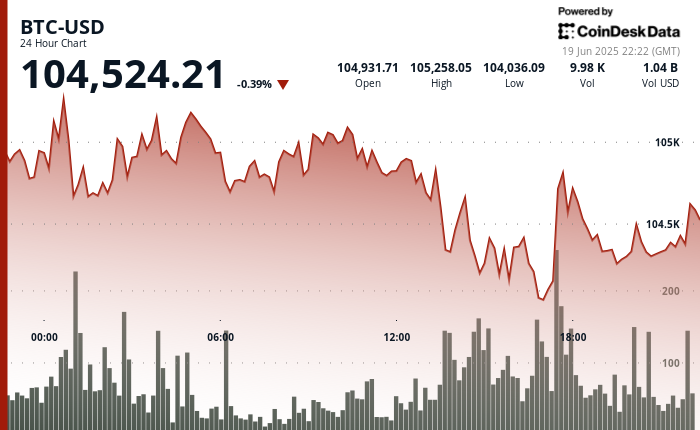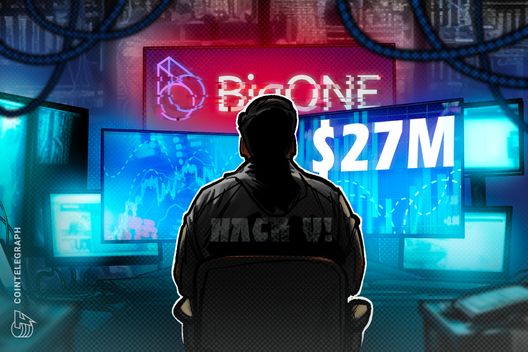Good Morning, Asia. Here's what's making news in the markets:
Welcome to Asia Morning Briefing, a daily summary of top stories during U.S. hours and an overview of market moves and analysis. For a detailed overview of U.S. markets, see CoinDesk's Crypto Daybook Americas.
As Asia begins its trading day, bitcoin BTC is trading above $104,500 and, despite a possible looming war in the Middle East, has been relatively flat on the day with negligible market movement. Indeed, for the last full week, BTC is only down 2%, according to CoinDesk market data.
Analysts are debating whether the crypto market’s current stillness is a sign of strength or if something more precarious is afoot.
Three new reports this week from CryptoQuant, Glassnode, and trading firm Flowdesk all point to the same surface conditions: low volatility, tight price action, and subdued on-chain activity. Additionally, retail participation has waned, and institutional players, from ETFs to whales, are now shaping the structure of flows.
But it’s CryptoQuant that’s flashing the most urgent warning.
In its June 19 report, CryptoQuant argued that BTC could soon revisit $92,000 support or even fall as low as $81,000 if demand continues to deteriorate.
Spot demand is still increasing, but well below trend. ETF flows have dropped by more than 60% since April, while whale accumulation has halved. Short-term holders, who are usually newer market participants, have shed approximately 800,000 BTC since late May.
Their demand momentum indicator, which tracks directional buying strength across key cohorts, is now reading negative 2 million BTC, the lowest in CryptoQuant’s dataset.

Glassnode, however, sees the same signals and arrives at a far less dire conclusion.
In its weekly on-chain update, the firm acknowledges that the Bitcoin blockchain is “quiet," meaning transaction counts are down, fees are minimal, and miner revenue is subdued.
However, this suggests that it may not be a weakness, but rather a reflection of the network’s evolution. On-chain settlement volume remains high, but it’s concentrated in large-value transfers, suggesting the chain is increasingly being used by institutions and whales.
The derivatives market, Glassnode notes, now dwarfs on-chain activity, with futures and options volumes regularly exceeding spot by 7x–16x.
That shift has brought more sophisticated hedging, better collateral practices, and a more mature, if less frenetic, market structure.
France-based Flowdesk, a market maker and trading firm, has views that fall somewhere in between.
While noting thinning altcoin flows and flat market-making volumes, its June 19 update describes the market as “coiled,” not cracking.
Flowdesk highlights a surge in tokenized assets, such as Gold-backed XAUT (up 56% in volume), stablecoin growth, and increasing RWA activity.
To them, low volatility may simply be the calm before a directional breakout, which is not necessarily downwards.
But in the end, no one seems to hold a reliable map for what’s ahead.
Even Polymarket isn't sure. Bettors are giving a near equal chance of BTC dropping to $90K in June or moving up to $115K-120K.
One thing is for sure: the tug-of-war between bullish institutional activities and waning retail demand potentially opens bitcoin up to dramatic moves on either side of the trade, which will likely dictate the market’s next chapter.

Presto Research Says Crypto Treasury Companies Have Less Risk Than You Think
A new report from Presto Research argues that Crypto Treasury Companies (CTCs), such as Strategy and Metaplanet, are not just leveraged bitcoin ETFs, but a new form of financial engineering with less risk than many investors assume.
Strategy’s latest raise, which raised nearly $1 billion via perpetual preferred shares, shows how BTC’s volatility can be used to an issuer’s advantage.
These securities, along with convertible bonds and at-the-market equity sales, allow CTCs to fund aggressive crypto accumulation without triggering margin risk.
Presto points out that Strategy’s BTC is unpledged and Metaplanet’s bonds are unsecured, meaning collateral liquidation, the primary trigger in past crypto blowups like Celsius and Three Arrows, is largely absent here. That does not eliminate risk, but it changes the nature of it.
The real challenge, Presto argues, is not crypto exposure itself but the discipline to manage dilution, cash flow, and capital timing.
Metaplanet’s “bitcoin yield” metric, which measures BTC per fully diluted share, reflects that focus on shareholder value.
As long as CTCs can manage the financial mechanics behind their accumulation strategies, they will earn NAV premiums just like high-growth companies in traditional markets. But if they miscalculate, the same tools that fuel their rise could accelerate their fall.
Semler Scientific Maps Bold Plan to Hold 105,000 BTC by 2027
Semler Scientific (Nasdaq: SMLR) has unveiled one of the most aggressive bitcoin accumulation roadmaps in corporate history, announcing plans to hold 10,000 BTC by the end of 2025, 42,000 by 2026, and a staggering 105,000 by the close of 2027.
The California-based medical device maker, which pivoted to a bitcoin treasury strategy last year, is effectively trying to 24x its current bitcoin stash of 4,449 coins over the next 30 months.
It plans to do so using a mix of equity raises, debt financing, and operational cash flow.
But the path forward isn’t guaranteed. Semler’s primary mechanism for acquiring bitcoin, selling new shares under its at-the-market (ATM) program, relies on the company trading at a premium to its net asset value (NAV).
According to data from Strategy-Tracker, Semler’s mNAV currently sits at 0.859x, meaning the market values the firm’s equity lower than its BTC holdings, effectively cutting off its ability to raise accretive capital.
That dynamic has made Semler something of a paradox in the world of bitcoin treasuries: a high-conviction buyer without the premium to fund its buying. Even as bitcoin has surged to all-time highs above $100,000, Semler shares are down nearly 40% on the year.
Market Movements:
- BTC: Bitcoin remains stuck below $105K despite strong ETF inflows, with repeated resistance at $105,150 and signs of institutional accumulation offset by short-term bearish momentum and macro volatility.
- ETH: Ethereum found support at $2,490 after a high-volume selloff broke key levels, with the price consolidating in a tight range amid geopolitical tensions and macro uncertainty, signaling potential for a breakout if resistance at $2,510 is cleared.
- Gold: Gold hovered near $3,366 on Thursday, little changed as escalating geopolitical tensions offset pressure from the Fed’s hawkish stance, while platinum retreated after hitting a near 10-year high; U.S. markets remained closed for Juneteenth.
- Nikkei 225: Japan’s Nikkei 225 opened 0.24% higher Friday as Asia-Pacific markets mostly rose ahead of China’s loan prime rate decision and amid ongoing Israel-Iran tensions.

 1 month ago
60
1 month ago
60








 English (US) ·
English (US) ·